Organisms and Environmental Variability
1/12
There's no tags or description
Looks like no tags are added yet.
Name | Mastery | Learn | Test | Matching | Spaced |
|---|
No study sessions yet.
13 Terms
Physiological Ecology
how an individual responds to its abiotic environment
– Emphasis: responses of animals to fluctuations in temperature
Environmental Change
• Organisms live in constantly changing environments
– Many temporal scales: daily, seasonally, annually
• Variation may be predictable or unpredictable
• Fitness depends on an individual’s ability to cope with environmental change
– To maximize fitness - an individual’s response to these changes must be shorter than the period of change
Individual Responses
• Responses to environmental change fall into 3 categories:
1. Developmental (usually occurs over a couple years) - typically irreversible!
• Individual alters its development to produce a phenotype most suitable to a present slow change in environmental conditions. Once organism develops into a particular phenotype, it can’t switch back.
2. Acclimatory (days – weeks)
• changes in response to seasonal variations, reversible!!!
e.g. thickening of fur for winter
e.g. frost hardening in plants
3. regulatory (seconds – minutes)
• Rapid changes in behaviour or rates of physiological processes, reversible response
e.g. shivering in animals
e.g. open/close stomata in plants
Focus on temperature...
Know these 3 types of responses, compare and contrast
Developmental
e.g. Wing length in European Water Striders (genus Gerris) – inhabiting temporary ponds
• Eggs hatch (spring)
•Adult lifespan is very short (reproduce & die during one summer)
Fitness/ability to survive is greatly dependent on the presence of the water.
2 morphs (discrete phenotypes)
Long winged
• can fly
• move if pond dries up
• more energy into survival than reproduction, more energy used to grow these wings, less eggs and less energy saved for reproduction, but they can move if pond dries up!!
Short winged
• cannot fly
• cannot move if pond dries up
• more energy into reproduction than survival
IF there is high temp during development, what phenotype would the fly develop into? If high temp during egg development, the flies will develop into long winged form, bc high temp means dry pond.
If there is lower temp during egg development, short winged flies develop.
Different temps, different developmental types will have varying fitness
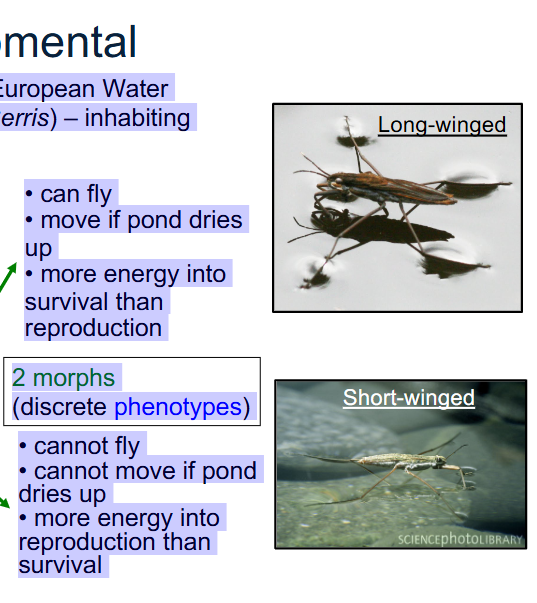
Acclimatory
= habituation of an organism’s physiological response to environmental conditions
• acclimation – applied to laboratory
• acclimatization – applied to nature
– Tolerances are not fixed but are preconditioned by recent experience with environmental conditions/variation in abiotic factors
e.g. Insect – freeze avoidance strategy
– as temperatures start to decrease in fall, insects physiologically change the composition of their body.
– convert glycogen reserves → alcohol (see in graph, glycogen reserves decrease as they turn it into alcohol, we see alchohol conc increase, freezing point depresses)
– alcohol depresses the freezing point of body tissues → freeze avoidance
Therefor, insects survive the cold winters. The reverse the process basically in spring, so it is a reversable process, similar to putting on fur and dumping it depending on the season in animals.
x axis: month
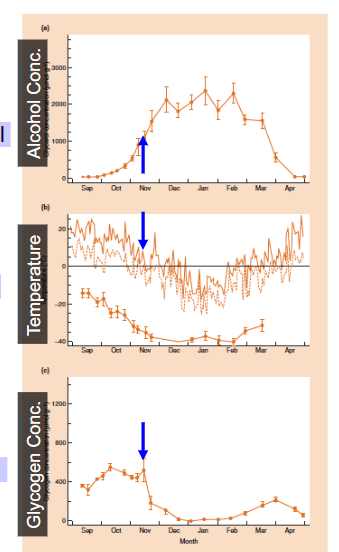
Variation in Regulatory Responses
Animals vary in their responses to environmental change
(1) conformers – allow internal conditions to change with external changes, conform to external environment
(2) regulators – maintain constant internal conditions under external changes
– homeostasis = maintenance of relatively constant internal conditions under external changes
• Always involves a negative feedback system
e.g. thermostat. Senses it’s too hot, turn heater off. It’s too cold, turn heater on.
1. Sensor – way to sense internal conditions and compares to set point, could be temp, oxygen, saline, some way to assess internal conditions and compare it to a set point where biochemical reactions are most optimal.
2. Response – way to alter the internal conditions to set point, to keep everything in the narrow optimal range
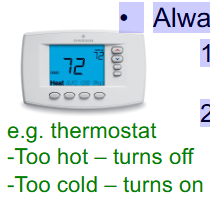
Thermoregulation
= maintaining internal temperature within a range, point where animals body preforms most optimal
• 2 strategies – vary by heat source:
1. endothermy= generate heat by metabolism, internal regulation of temperature
– Birds, mammals ~ 36-41°C
– High energy costs but active in wide temp range, needs to consume a lot of food to maintain the ability to thermoregulate
- advantage: can reproduce and do stuff in a wide variety of temperatures
2. ectothermy= gain heat from external sources, no way to internally regulate thermal conditions
– most animals are ectotherms, invertebrates, fishes, amphibians, reptiles
– Low energy costs but only reproduce/be active in narrow temp range. Don’t use up alot of energy stores to regulate temperatures, do it behaviroually, but they are not very active, good at surviving or reproducing if the external temperature is outside of their optimal range. Need a lot of temperatures avaliable,
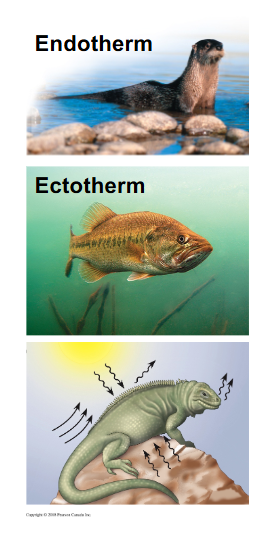
Variation in body temperature
• poikilotherm = body temperature varies with environment
– Typically ectotherms, but some endotherms vary body temps, have different set points of temp, they don’t maintain in the specific set range
e.g. bats, hummingbirds...
• homeotherm = body temperature does not vary with environment
(maintain relatively constant internal conditions)
– Typically endotherms but some ectotherms maintain relatively constant body temps
e.g. fish, inverts, and ectos living under very stable temps
Limitations of ectotherms
Ectotherms must behaviourally generate heat, under certain environmental conditions they won’t be very active
• Ectotherms generate heat when active
Advantage: don’t need energy to power internal temp regulation processes
– disadvantage: every aspect of ecology and behaviour is influenced by the need to regulate
body temperature
e.g. digestion in fish is strongly influenced by water temperature, ex. moving down to cold water to get food, fish can’t digest as well, but they move up to the warmer water to digest and use food to grow
→ Move to warmer water to ↑ digestion (↑ growth)
Moving up and down all day to get food and then digest it and grow. This movement is driven by their need to regulate internal temperature
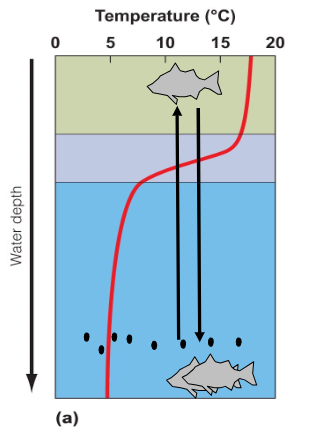
Limitations of endotherms
• Endotherm’s ability to maintain constant body temperature is limited under low temperatures
– Short-term – by physiological capacity to generate heat, ex. shivering, need to use up internal energy stores
– Long-term – by ability to gather food (or energy) to satisfy requirements for metabolic heat production
• animals usually starve to death before they die of direct causes of cold temperatures, use up all their energy reserves staying warm.
We see adaptations that try to reduce amount of energy used maintaining internal temp throughout different conditions
• Reduce energetic costs through adaptations that alter the lose/gain of heat from environment in a number of ways...
Try to reduce the gradient of body temp to environment, amount of temp lost depends on steepness of gradient.

Energy conservation methods - endotherms
1 . Lower regulated temperature of a portion of their body (circulatory adaptation)
e.g. Birds – regulate blood flow to skin
– Counter-current heat exchange keeps blood warm, heat is lost from arteriol blood to veinous blood, less of a gradient and less heat loss
Heat is lost greatly through feet of birds, since there is no insulating fur to prevent heat loss.
Heat loss is minimized by reducing temperature gradient between body and external environment, See it in tails, flippers, feet, etc.
Lower regulated body temp (set point) over periods, ex. day temp is higher and night temp is lower, allow body to very about two different set points
e.g. hummingbirds, bats
• torpor= temporary(daily) reduction in metabolic activity and body temperature
• hibernation= extended reduction...
(e.g. over the winter)Graph: oxygen consumption: metabolic activity measure
Aroused state: using up a lot more energy
Torpid: using less energy
• Inactive at low temps:
– body temperature is regulated around a different (lower) temp
– 50% less energy consumed.Conserving body reserves by reducing the set point
– Heat loss is minimized by reducing the temperature gradient between body and ambient environment,
→ otherwise would starve to death overnight! if they didn’t go into torpid state. EBcause their prey is the same, they would use up their enery reserves trying to find prey.
3. Larger body size...
• Body size is one of the most important animal characteristics
– body size dictates the morphology, ecology, physiology of an organism
– importance is due to Allometric Relationships
= relative increase in a physical or physiological property in relation to body size
• Basal metabolic rate (BMR) = metabolic rate of endotherm at rest
• Metabolic rate ~ body mass 3/4
• Smaller animals have higher BMR per gram than larger animals
Look at graph on next card
Key reason for higher BMR per gram of smaller animals is the surface area to volume ratio...
Little mouse, not a lot of volume compared to surface area. But an elephant has much more volume compared to surface area
As body size increases, volume changes faster than surface area, ratio changes, amount of heat lost to environment changes
• The larger the volume, the greater the total amount of heat required to keep warm
... but less heat is lost through the outer surface of the organism
• Small animals: high SA relative to low volume → lose lots of heat through high SA
• Large: low SA relative to high volume → lose less heat through low SA
Endothermic animals must reach a critical size: heat generation >> heat loss
As body size ↑, V ↑ faster than SA
As SA/V changes, heat loss to environment changes
As body size changes, SA/V changes
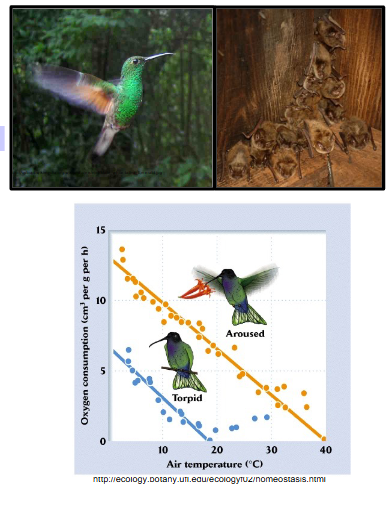
Energy conservation - endotherms
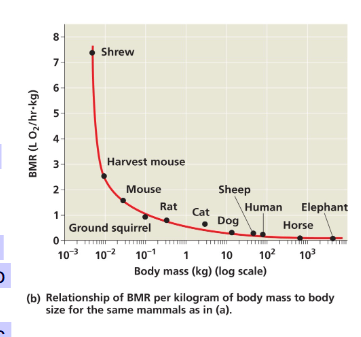
Summary
• Fitness depends on an individual’s ability to cope with environmental variation
• Individual responses may be developmental, acclimatory or regulatory.
• Animals vary in their responses to temperature change and constant internal conditions are either maintained (homeotherm/regulators) or vary (conformers/poikilotherms)
• Organisms can regulate their body temperature by gaining heat from external sources (ectotherm) or through metabolism (endotherm)
– The energetic costs of endothermy are high and can be minimized by reducing heat loss to the environment by: countercurrent heat exchange, lowering regulated temperature of a potion of the body (bird feet) not loosing too much heat from their body into the environment, lowering regulated temp at certain times of day (torpor) increasing body size (changing SA/V ratio). Can’t loose more heat than they are able to generate. Becoming bigger can help conserve energy.